
Part Two: Preparing for International Practicum
As discussed in part one, we are faced with complex global challenges such as conflicts, disasters, and multiple forms of oppression. The profession of social work is engaged in addressing these challenges in various capacities. It is critically important to prepare social workers to practice in an international context and to adequately address these global challenges. This could be accomplished by engaging students in international practicum. However, it is important that students are well-prepared to have a successful international field placement experience. As such, part two of this training focuses on the logistics of preparing for an international practicum placement including preparation requirements and pre-departure planning, language and culture considerations, and financial support. It concludes by exploring the current models of international field practicum.
Preparing for an International Practicum
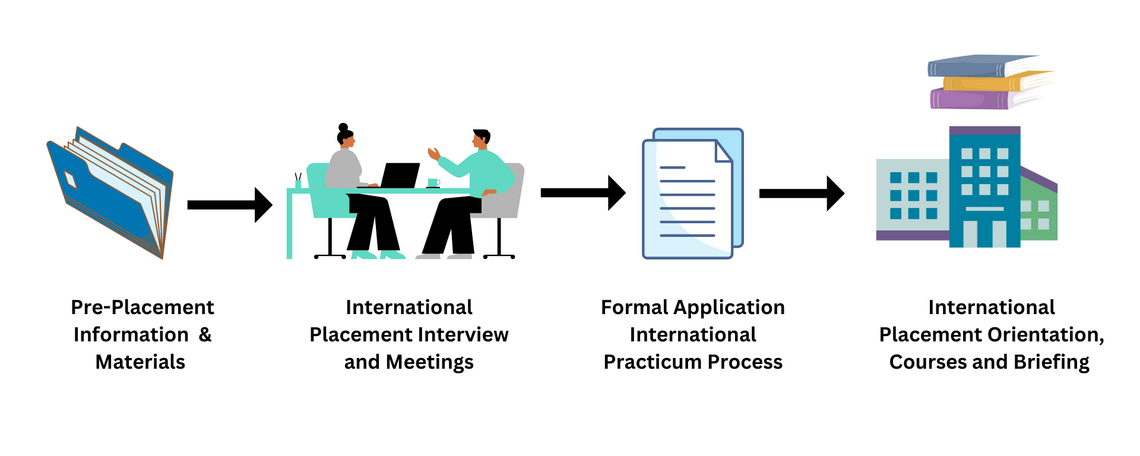
International Practicum Preparation
Preparing for an international practicum takes considerable planning and coordination to ensure that students have a successful and meaningful experience (Berdan et al, 2013; Filak et al., 2019; Lager et al., 2010). To successfully plan an international placement, it is recommended that the student meets with the field education coordinator or director well in advance of the anticipated field placement as well as other university offices as needed (this may include student services, risk management and insurance, international office, or equivalents) to ensure that all requirements for completing an international practicum are met (Pawar et al., 2004). Students should also compile an overview of social work agencies, organizations, or systems they would like to work with based on their interests and learning goals. It is a common practice that all field placements must be formally approved by the field education office well in advance of the practicum start. Often, the student application process for an international practicum should be initiated at least six months to a year prior to the beginning of the international practicum.
- Does my post-secondary institution or program offer the option to do an international practicum?
- Am I a suitable candidate for an international practicum?
- Why do I want to do an international practicum?
- Where do I want to do an international practicum?
- What are my learning goals for practicum?
Typically, students submit a practicum proposal to the field education office for approval. The practicum proposal may ask to include information such as language skills and proficiency, courses completed (e.g., international social work or directed studies in the proposed region), health and/or vaccination requirements (for e.g., vaccine requirements related to the COVID-19 pandemic), any past experiences in learning abroad, and anticipated safety issues.
- Good academic standing
- Completion of all core courses
- Application or proposal for international practicum
- All inquiries go through the field education coordinator
Interview - Review and approval by the field education committee
- Students are required to find a placement and decide on the location of the placement
- Pre-departure seminar
- Language efficiency
- An overview of the host country, culture, and general research on the country’s social systems.
- Risk management process at the University
It is important for field educators to support students in thinking through the logistical planning to meet their practical goals of completing a practicum abroad. However, the pedagogical and theoretical underpinnings of a proposed international practicum are a time-intensive process for field educators. Therefore, institutional support is required to ensure that field educators have the time and resources necessary to work with students in coordinating safe, appropriate, and enriching international practicum opportunities (Lough, 2009).
- Meet with a medical doctor to renew any prescriptions for an extended period as well as acquire any required medical supplies, equipment, and access to necessary personal health information
- Look into required vaccinations and health and travel insurance
- Secure the necessary travel documents
- Confirm accommodations in the host country (e.g., student residence options)
- Establish a means for communication between student and field educators prior to departure
Preparation for an international practicum involves both formal and informal elements (Schwartz et al., 2011). Many social work field education programs provide formal preparation for students, which can include: (1) orientation seminars, (2) pre-placement interviews, and (3) pre-departure courses. Orientation seminars vary from program to program. Some programs offer pre-departure and ongoing seminars to assist students in planning and preparing for international practicum. Field education coordinators or directors may wish to meet with students who express an interest in pursuing an international practicum to learn more about their interests, motivations, and background as part of the selection or matching process.
For example, students can be invited for an interview with the international field agency and with the field education coordinator or field team. Some international organizations and university international offices or study abroad centers also provide formal pre-departure courses for students undertaking an international activity. In addition to these formal preparatory seminars, interviews, and courses, students should also be encouraged to engage in informal preparations. This can include researching the host country and connecting with fellow students who have international practicum experience (Dunlap & Mapp, 2017; Jones et al., 2018; Schwartz et al., 2011).

The Logistics of Preparing for an International Practicum
It is important for field educators to support students in thinking through the logistical planning to meet their practical goals of completing a practicum abroad. However, the pedagogical and theoretical underpinnings of a proposed international practicum are a time-intensive process for field educators. Therefore, institutional support is required to ensure that field educators have the time and resources necessary to work with students in coordinating safe, appropriate, and enriching international practicum opportunities (Lough, 2009).
Before students leave for an international practicum, field educators will encourage students to consider the following pre-departure tasks:
- Meet with a medical doctor to renew any prescriptions for an extended period as well as acquire any required medical supplies, equipment, and access to necessary personal health information
- Look into required vaccinations and health and travel insurance
- Secure the necessary travel documents
- Confirm accommodations in the host country (e.g., student residence options)
- Establish a means for communication between student and field educators prior to departure
Additional Considerations for Preparation
The following are other considerations relevant to engaging in an international practicum:

In Canada, students are most often responsible for all travel and other related costs associated with an international practicum. While only a few Canadian social work programs offer financial support, some programs may have scholarships or awards available to provide partial funding for students. It can be helpful for students and field educators to identify a list of available scholarships and awards at the university level, as well as any potential sources of funding at the provincial or federal level.
Some of the costs associated with an international practicum for students can include:
- Housing and accommodation
- Airfare and visa application
- Food and meals
- Local transportation within the country Recreational activities
- Health insurance and vaccinations Other expenses (e.g., internet, cell phone)
Typically, BSW and MSW students will have to provide their own funding, so there should be a considerable amount of time set aside for financial planning and assessment. Preparing a budget is a necessary step to do before the placement start date. Some universities may provide financial support for international experiential learning through scholarships, grants and bursaries, endowment funds, or through university financial aid budgets specifically designated for study or internships abroad. Some universities have agreements or partnerships with post-secondary institutions in host countries, which can help to alleviate some of the financial constraints. Students are encouraged to identify potential sources of financial support that might be available for social work students wishing to pursue an international field placement. Since the social work practicum is a required course, students may be able to apply for student loans or aid for their studies. It is strongly encouraged that students check with their bank and determine if they are able to use credit or debit cards in the host country as well as the regulations on currency withdrawals and exchanges.

Before starting an international practicum, students should conduct extensive research on the host country. Students will need to consider the possible language barriers they might encounter. In addition to language, additional preparations and considerations may include:
- Elective courses in international social work, and language courses through independent or directed studies
- Understanding cross-cultural communication and enrolling in a cross-cultural training course or program if it is not already provided through your social work program/institution
- Establishing an overview of the cultural, historical, political, and economic characteristics of the host country
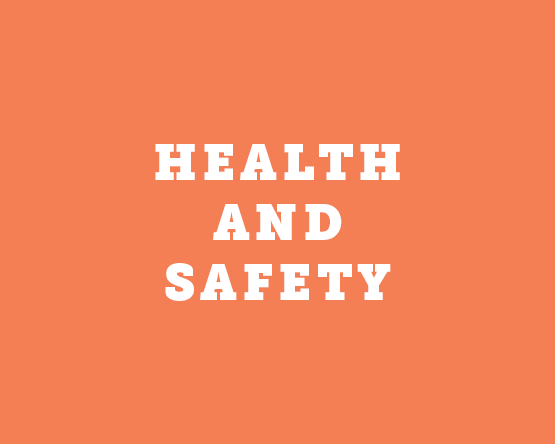
Students are advised to meet with a medical doctor to renew and acquire any prescriptions, required medical supplies, equipment, and access to personal health needs necessary for their time abroad. Students are advised to plan for required vaccinations, as well as health and travel insurance.
It is important to research health advisories and recommendations for the destination country For safety, be sure to research the country's laws and investigate online resources or travel guides regarding travel safety. It is important to know how you can access health services in the destination country and what documentation you will need to provide. There are a number of useful health and safety links available through Government of Canada. Some are listed below:
- Travel advice and advisories by Destination: The Government of Canada’s official source of travel information and advice, the Travel Advice and Advisories help you to make informed decisions and travel safely. Check the page for your destination often, because safety and security conditions may change.
- Canadian Centre for Occupational Health and Safety: Canadian Centre for Occupational Health and Safety offers various courses on health and safety.
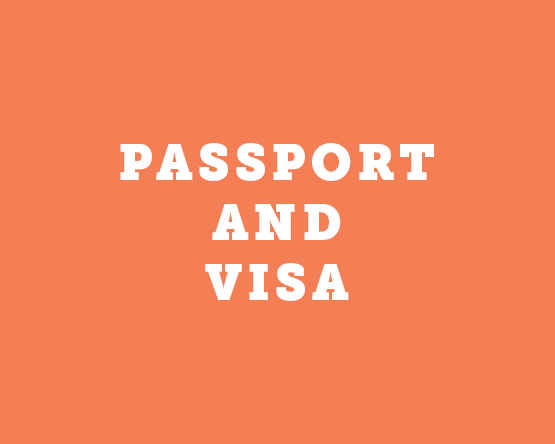
Students are encouraged to secure the necessary travel documents, such as a passport and any required travel visas. For visa and other travel documents, students may
wish to visit Government of Canada.
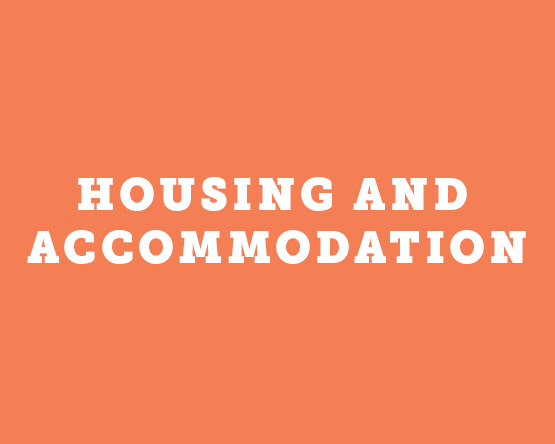
Students are advised to make necessary plans for accommodations in the host country (e.g., student residence options). Check with your university to see if they have any partnerships with other institutions in the same city of your destination country. If partnerships are available, check if you are able to access the dorms on the university campus. Other options for housing and accommodation include homestays, apartment rentals, Airbnb, or staying with family or friends. Planning for housing and accommodation should be done in advance as some of these options (homestays and apartment rentals) require interviews, deposits, and additional considerations.
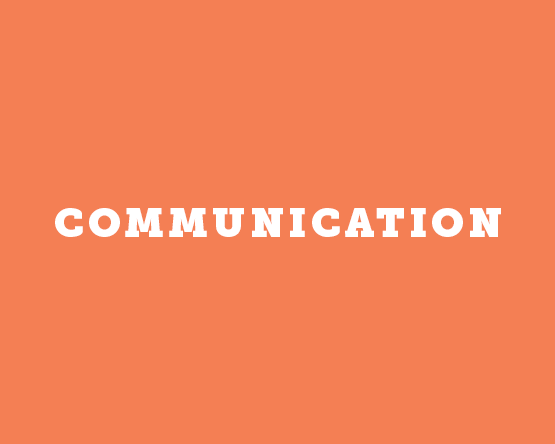
Students and field instructors are encouraged to establish a means of communication prior to departure. Ensure that you take into consideration the differences in time zones when planning for communication from overseas.

It would be beneficial for students to begin working on the learning agreement prior to reaching their destination, as this will allow for reflection on desired learning goals during placement. A conversation between the student and field supervisor would be beneficial at this time to discuss the learning agreement and acknowledge its use as a live document, so changes and additions can take place once in the practicum setting.
Current Models of International Field Practicum
This section of the training module provides an overview of the current models of international field practicum. The most common models of international field placements are the on-site model, the one-time model, the reciprocal or exchange model, and the neighbor-country model (Cleak et al., 2016). These models are explained in further detail below:
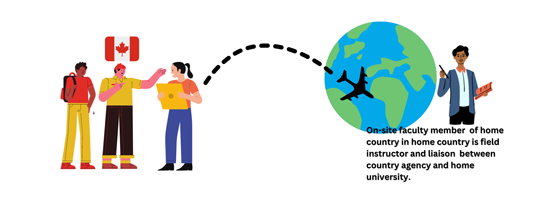
On-site faculty member of home country in home country is field instructors and liaison between country agency and home university.
On-site Model
The on-site model involves one or more on-site faculty members in the host country who act as field instructors and field liaisons between the agency and the home university (Pettys et al., 2005). Practicum placements are initiated by one or more on-site faculty members who contact the host agency. In terms of screening requirements, a special application package submitted to the on-site field instructor is often required. There tend to be extensive pre-departure and country orientation requirements.
Independent or One-time Placement Model
This model often focuses on student’s interests or experiences in a particular geographical location (Nuttman-Shwartz & Ranz, 2014; Fox & Hugman, 2019). Informal linkages can be facilitated by existing family members or personal contacts in a particular country or region (Fox & Hugman, 2019). There is no formal affiliation or agreement between the home university and the host agency prior to placement. Students find their own placement and contact with a host agency is initiated by the student with the field team’s permission (Fox & Hugman, 2019). There is often no requirement for a particular application or screening, and the interview process includes a one-on-one meeting with the field supervisor.
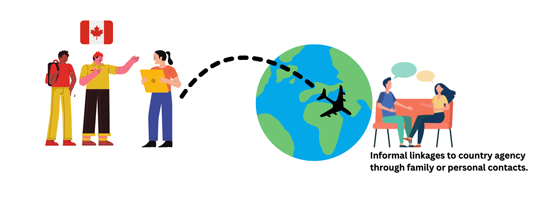
Informal linkages with country agency through family or personal contacts
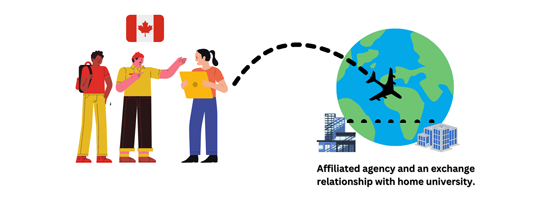
Affiliated agency and an exchange relationship with home university
Reciprocal or Exchange Model
The reciprocal or exchange model involves an affiliated agency in another country and an exchange relationship with the home university (Pettys et al., 2005; Nuttman-Shwartz & Ranz, 2014). It is the most demanding model for home universities due to the requirements to provide student funding through scholarships or other funding through the university. The benefit of this model is that it is a potentially sustainable model for international placements and builds on long-term relationships (Nuttman-Shwartz & Ranz, 2014). The screening process is often extensive as students must meet specific requirements and include a local and specialized application package. There are also extensive pre-departure and country orientation requirements. The home university initiates the first contact using long-term exchange relationships and affiliation agreements with host agencies.
Neighbour-country Model
The neighbor-country model consists of neighboring countries in geographical proximity and are often chosen by students who are citizens or residents of that country (Fox & Hugman, 2019; Nuttman-Shwartz & Berger, 2012; Pettys et al., 2005). These placements, which typically are considered local placements, often involve social work programs located in geographic proximity to an international border, such as Canada or the United States. There is no requirement for a particular application or screening and there is oftenminimal pre-departure and country orientation requirements, due to the close geographic proximity. The practicum typically is initiated by the field education coordinator at the home university or by contacts in the host agency.
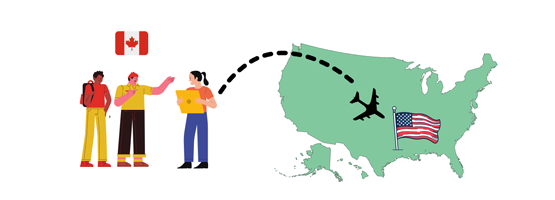
The current evidence-based models of field education include the on-site model, the independent or one-time placement model, the reciprocal or exchange model, and the neighborhood country model. Knowledge of these models is important as each model may require different considerations during the preparation, arrival, practice, and return phases of the international field experience.
